The Birth, Rise,
and Briny Future
of Pickleball in Santa Barbara
Pickleball Takes Over!
By James Buckley Jr. | June 15, 2023

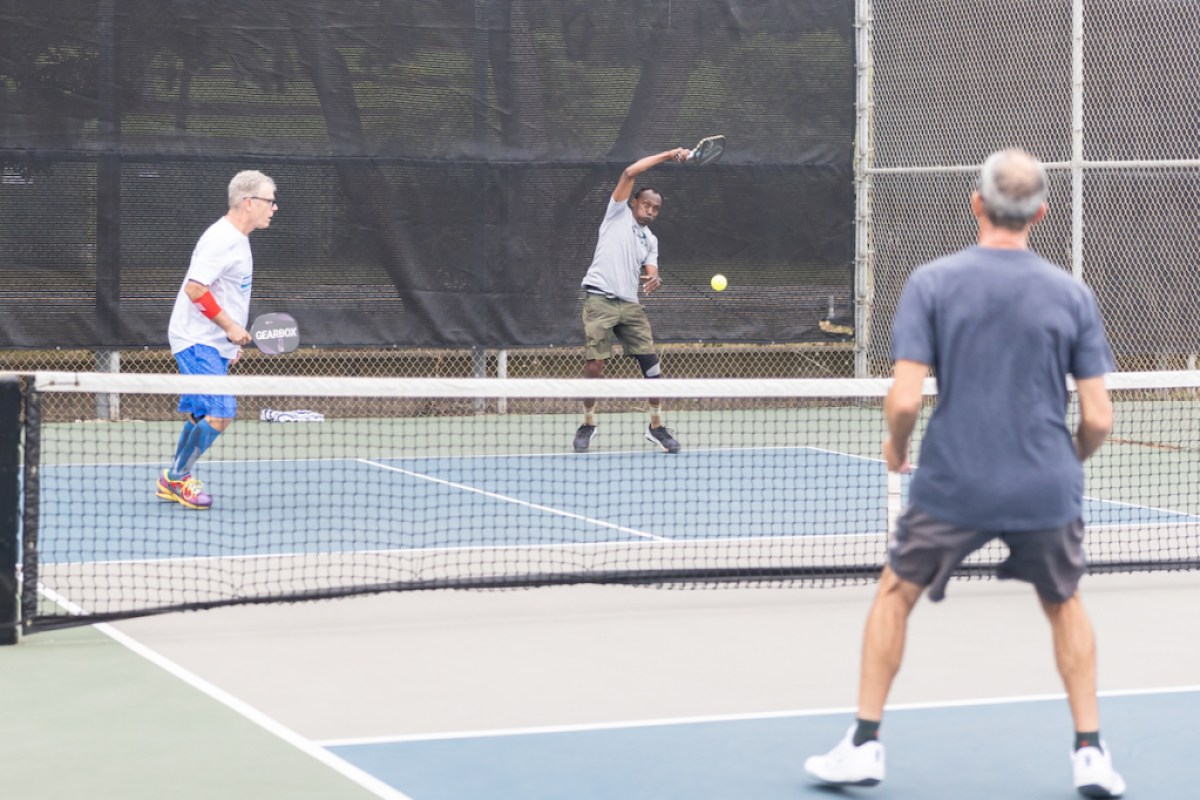

What is round, yellow, goes “thwock-thwock-thwock,” and actually benefited from COVID-19?
Pickleball, of course.
Pickleball is, for the seven people reading this who haven’t read about it somewhere else, a racket sport played on a small court using a plastic ball with holes in it. It was created in 1965 by a group of bored vacationers in Washington State who cobbled together an activity one afternoon using a variety of lonely sports gear. (The game’s name, by the way, does NOT come from one of the inventors’ dogs, as legend has it. Apparently, in crew racing, a “pickle boat” is one made up of random rowers, much as the game came together from disparate parts. Pickles the dog came along later.)
Pickleball hibernated in the hinterlands of America’s diverse, slightly wacky sports community until perhaps 10-12 years ago, when, for reasons that remain murky, it began to slowly shoot out buds of interest in more and more places. Retirement communities in Arizona and Florida seemed to be the forerunners, as the sport proved to be perfect for active seniors (and seniors-to-be). Then came the pandemic, and the sport proved to also be perfect for outdoor social distancing plus exercise. It was a massive dose of adrenaline, and pickleball has exploded, as documented by ESPN, Sports Illustrated, and lifestyle sections of media everywhere. Some studies say the growth has been from the low hundreds of thousands of players to nearly nine million American pickleballers in the last half-dozen years alone, let alone a growing international contingent: boule de cornichon, anyone?
Being at first a game most beloved by the graying set (but with interest expanding downward in age), pickleball nationally is packing courts into retirement communities like they once put down shuffleboard alleys. In Missouri, Connecticut, and New Jersey, among other places, pickleball courts are filling up deserted mall spaces like Bed, Bath & Beyond (paying attention, Paseo Nuevo?). Of course, with all this interest, someone’s also trying to make money. Sports Illustrated reported in depth last fall about a feud among dueling pro pickleball leagues (that at one point led to having three Pickleball Halls of Fame in the planning stages), and celebrity money (Tom Brady, Kevin Durant, etc.) is poking in at the edges — everyone is trying to jump on the pickle wagon.
But our story is focused right here in the 805, tracing the birth, rise, and briny future of pickleball. As with any successful venture, the key is community. And pickleball has that aspect of sports down pat. As you’ll see, what really sets it apart from other sports that adults take up in years far distant from Little League and rah-rah varsity sports is that sense of togetherness. The games are short, teams switch partners regularly, the focus is (for the most part) on fun, and, well, it turns out that people like to hang out with other people. Who knew?

Johnny Pickleseed
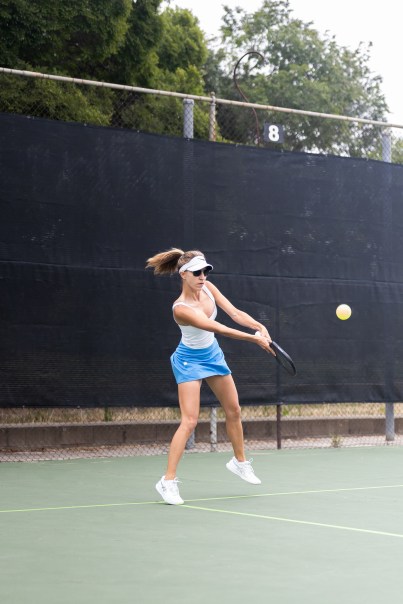
Longtime tennis player and retired software executive Jim Coffman became the Johnny Pickleseed of Santa Barbara. Though he had played tennis with the famed Montecito Mafia for 30 years, “as soon as I started pickleball,” which he picked up near his second home in Newport Beach, “that was the last time I played tennis.” In 2014, Coffman showed up in S.B. with the first pickleball paddles and balls. Once he taped out the lines of the first local court, however, the next challenge was filling it.
“Surprisingly, I could not find one person in Santa Barbara who had ever even heard of pickleball,” he says. “I did eventually find a couple of folks, the Campbells, willing to join me, and then [former longtime UCSB women’s volleyball coach] Kathy Gregory made our fourth. We started playing once a week at the Montecito Country Club [where Coffman is a member].”
“We played for a month or two, then I asked Rich Hanna at the city Department of Parks & Rec to come watch,” Coffman continues. “He realized the potential for pickleball and asked us to tape up four pickleball courts at an underused court at the Municipal Tennis Courts.” Those venerable concrete pads, colloquially called “Muni” (rhymes with “loony”) and located on Old Coast Highway above Highway 101, were the site of the first Pickleball Day in our town in November 2014.
Coffman began his campaign to get people picklin’ in earnest. With the dedication of a true zealot, Coffman and his early pickleballers spread the word, gathering new players. Coffman became the first coach, soon joined by others, and was even the first equipment supplier. He bought pickleball paddles and within the first year or two had sold more than 100 in Santa Barbara (he’s not in it for the money). “Borrowing a paddle is one thing, but owning a paddle meant you were committed,” he notes. (Pickleballers of today can visit the recently opened Santa Barbara Pickleball Shop on Milpas Street for all their non-edible pickling needs.)
The thwocks just kept on comin’ as Coffman and friends put up fliers, sent out emails, cajoled, exhorted, and otherwise tried to get S.B. pickled.
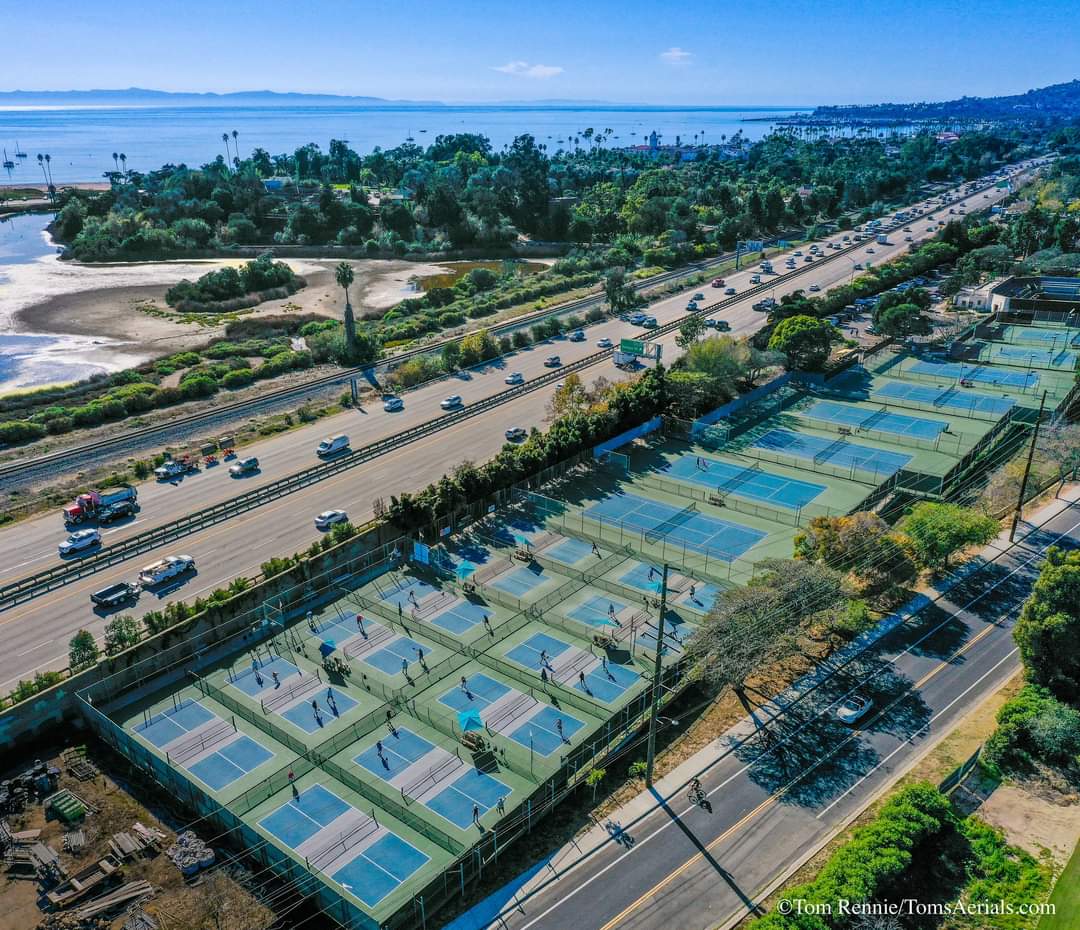
“My personality is ‘make it happen.’ So when I found something I liked and I had the time, I just felt it was something I could do,” he said. Coffman earned his free time by selling software businesses in the early ’90s. Now, at a tan and incredibly fit 83, he’s the “Godfather” of Santa Barbara’s part in America’s hottest new sport.
“There were zero courts until Coffman arrived,” said Richard Salzberg, who inherited the official U.S. Pickleball Association (USPA) Pickleball Ambassador sash from Coffman. “Fast-forward to today, we believe there are about 100 courts in Santa Barbara, Carpinteria, and Goleta. That includes courts at private clubs as well as at private residences.”
Indeed, these days, Muni now sports 12 courts, hosts scrambles (i.e., show up and jump into a game) almost every day, and is the site of an annual charity tournament. How fast did the sport grow here? “Annual pickleball Muni permit-holder numbers are up drastically,” reports Payton Moore of the Santa Barbara Parks & Recreation Department. “At the end of 2014, there were 90 active members. Through early 2023, we’re at 1,051 annual passes.”

Pickleball Basics
Pickleball is like tennis after a shrink-ray. Four people play on a
court that is only 44 feet long and 20 feet wide, a space so small
that four courts can fit on a standard tennis court.
The sport is almost always played as doubles, two players
on each side of a thigh-high net.
Short, lightweight, rectangular-ish paddles are used to whack a ball about the size of a moderate orange (and usually the neon yellow color of a safety vest) back and forth.
A seven-foot area closest to each side of the net (nicknamed “the kitchen”) can’t be entered into except to hit a bouncing ball, eliminating volleys smacked at the net.
As in tennis, play starts with a serve. Like old-fashioned volleyball, teams can only score while serving.
The ball can bounce once on each side, and you earn a point if your opponent hits the ball outside the lines or can’t return the ball to your side of the court.
Games are first to 11 points, and you have to win by two.

Pickling Goleta and Battling Noise
Once the sport had conquered Muni, it looked beyond and found a willing audience in other parts of town. Evergreen Park in West Goleta has offered several courts since about 2015. Goleta also sports a lighted, five-court setup behind the Goleta Valley Community Center. That pickle barrel is the baby of a longtime pickleballer who, like Coffman, brought the game with him. Mike Myers grew up playing pickleball (“since 1977!” he said proudly) near Tahoe. When he moved to Santa Barbara about seven years ago, he and his wife sought out a place to play. Muni was fine, and then they tried Pershing Park’s tennis courts, but they wanted lights so they could play after work.
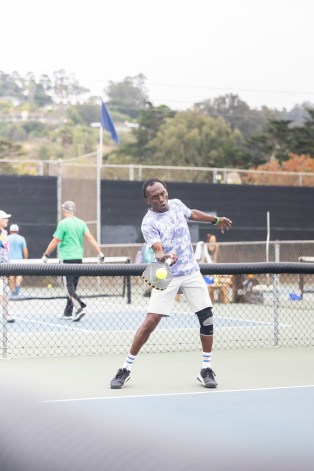
“I connected with Charlie Johnson at what was then Goleta Valley Athletic Club [now GV Community Center],” Myers says. A temporary court had by then been washed away, but Myers got the go-ahead to actually paint courts. Johnson expressed unease about creating so many, but Myers said confidently, “I can fill these courts.”
He wasn’t wrong. The Goleta courts are now as busy as Muni, filled most of the time from 8 a.m. to 8:30 p.m. every day of the week.
Like everyone involved with the sport, Myers is devoted. Even though he’s in his fifth decade (he started young!) on the court, he still maintains that he is “trying to continue to get better and better. There’s always something to learn out here. But I also love coming out here for recreation and being around people I know. The camaraderie is a big part of the appeal.”
Still, he says, he is constantly surprised by the way the sport has mushroomed. “It’s insane. I still talk to the family I grew up playing with. And we all just can’t believe that it has caught on so much. What is nice is that for the most part, it still has that feeling of friendly family fun.”
Another player who helped give birth to new pickleball pads was Dave Wilcox. He says the sport actually put him on a new path in life. He had played tennis, racquetball, Ping-Pong, all the racket sports. “But to be honest, my weight was getting out of control. Since taking up pickleball, I’ve lost 50 pounds,” he said as we sat courtside.
Wilcox had been working with a local pro who was teaching him the game. But early on during COVID, the coach moved out of town. So Wilcox took his knowledge, added to it, and became a coach himself. He got a license from USPA and became the instructor at Muni. Then, when pickleball was classified as one of the “safe” sports mid-pandemic, “COVID was gasoline poured on a small fire,” says Wilcox. Within a few months, he went from teaching one class a week to 11.
At the same time, also thanks to COVID, Wilcox’s day job at UCSB managing dorms got much less busy. So he and his wife, Tracy, formed Dynamite Pickleball as a business to teach the game. Of course, you need a court to coach on, and they found their home by subleasing the roller-hockey rink at Earl Warren Showgrounds, which added another seven courts to the area’s growing inventory.
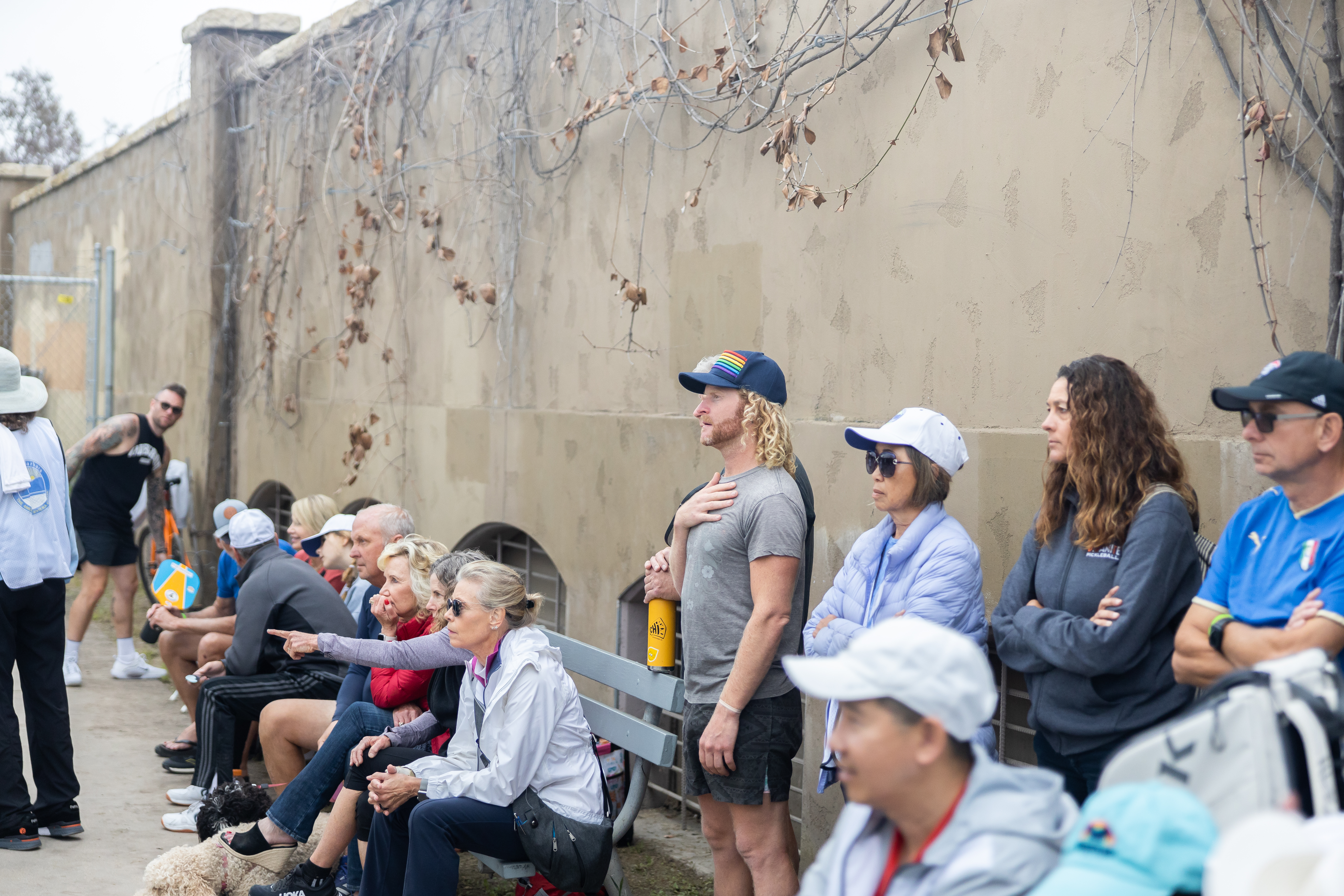
Wilcox faced the same challenge that the Goleta courts and several private and club courts in Montecito dealt with: the noise that issued thwockily from those paddlin’ picklers. It is, they all admit, louder than the “thwap” of tennis balls. Local court builders weren’t alone; the rise of pickleball has forced communities across the country to try to figure out a balance between the right to sweat and the right to not have to listen to it all day. In 2021, a pickleball noise battle in Montecito made national news when well-to-do neighbors of the country club forced a temporary halt in the use of the courts while noise issues were resolved. The Goleta courts also faced pressure from nearby neighbors. In 2022, compromise was reached and the Goleta City Council voted unanimously to make the courts permanent, though noise abatement measures were put in place and more were on tap if needed. Wilcox notes that his courts at Earl Warren use some landscaping and some sound-absorbing netting to help de-thwock things a bit … but that the noise is part of the deal.
What’s the actual problem? Audio scientists who have looked at the problem point to the thwock’s higher pitch than the tennis ball’s thwap, not necessarily to the actual decibel volume of the sounds.
Meanwhile, back at ground zero for Santa Barbara pickleball, Coffman says with a laugh, “We have it easy at Muni. In fact, the only complaints we get are from out-of-town tournament players who think the [nearby] freeway noise is too much!”

Pickle Power
So what’s the real appeal, other than the fun name? New players are mostly attracted to the ease of entry. It’s just not that hard to learn the basics and get good enough to play.
“It’s a sport that’s easy to learn and hard to master,” says Wilcox. “That second part keeps people coming back. They can play very comfortably very fast, but they can also see that playing more will help them improve.”
Everyone also points to the fun of doing things with friends — and making new ones. “Tennis players are used to the same foursome,” says Salzberg. “Pickleball is a much more social sport. I’ve made so many personal friends playing, we do things outside the sport, too. And by playing with people you don’t know, it becomes a real community.”
The game does attract — but is far from limited to — an older demographic. In the constant search for a way to stay active that is not boring or repetitious, pickleball has really thwocked a sweet spot.
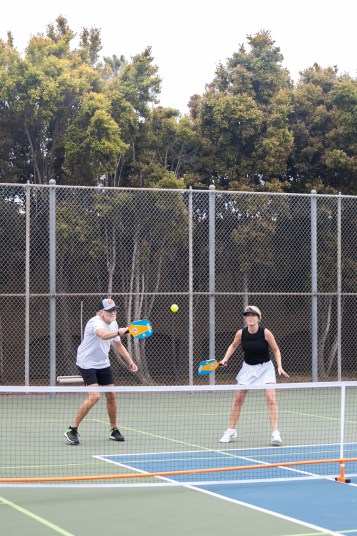
“I’ve gotten letters from people thanking me for getting them off the couch,” says Coffman proudly. “Remember, you have just a small area to cover. It’s a step to the right, a step to the left, and four steps forward. It’s much easier to get someone started than it is in tennis.”
“For me and so many people that we teach, it’s the feeling of being a kid again,” Wilcox says. “I get to go out and play and be competitive in a sport like when we were young. You’ll hear over and over again about the relationships that are quickly built playing pickleball. The thing you hear more than anything on a pickleball on the court is the sound of laughter.”
“I never thought I’d make new best friends at this stage of my life,” says Anna Anhalt, who plays regularly at the Goleta courts. “But that’s what happened, thanks to pickleball. The group I met on the courts has added a book club and mah-jongg. We’re even planning a group trip to Oregon this fall!”
“It’s almost like an addiction,” says Felipe Tapia, who was a top tennis player in his native Chile before switching to soccer when he moved to Santa Barbara as a young man. In pickleball, he found a return to the sport of his youth … sort of. “It was easy to move from tennis to pickleball, but most of the people I play with have never played tennis. Once you start learning the technique and the tactics in pickleball, you’re into it. Anybody can enjoy this.”
As it happened, the numbers of people playing tennis increased during COVID as well, according to national statistics. Is there room for both in Santa Barbara? So far, coexistence seems to be the watchword, with tennis not booming nearly as fast as pickleball. Also, on one tennis court, four people can play doubles tennis for an hour. In the same time, two dozen people (or more) can play on four pickleball courts taped onto a tennis court. As is true in most sports, big numbers usually win, though the pickleball organizers are quick to note that they want to grow the pie, not hoard it all for themselves.

What’s Next?
Coffman has set up a few courts in Carpinteria, and he hopes to add more in his expanded role overseeing the sport for the USPA for the entire Central Coast. Wilcox is in negotiations to build even more courts at Earl Warren, including some that will be covered for play in bad weather.
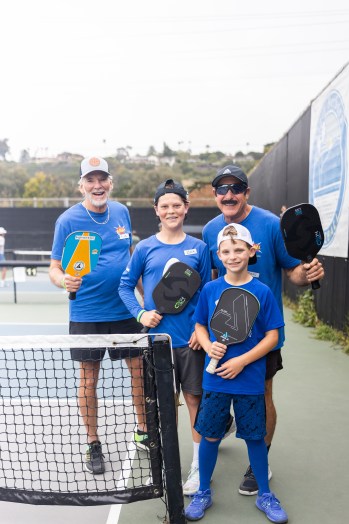
Moore of City Parks adds, “Some things down the pipeline are some possible new court projects, and lights are on the way for the Muni courts, too. That will increase playability exponentially. This is going to be a really solid sport for our community.”
Moore is such a believer — “I play all the time; I wish I could play more!” — that he spearheaded a competitive pickleball league, which has expanded to two eight-week seasons twice a year (sign up at the City Parks & Recreation website). Played at Muni, there are men’s, women’s, and mixed doubles brackets, including playoffs and champions. More than 70 teams have taken part in recent events, and any doubles team can sign up, said Moore. The next league starts in August.
Everyone involved also has their eye on the next generation. “Kids are an untapped market,” notes Wilcox. “Our camps this summer are all aimed at ages 6 to 16. Goleta will have two free pickleball events for youth and others in July, too.” Coffman noted that his granddaughter tried both tennis and pickleball with him … and chose to pickle.
Also, Coffman and Salzberg are using their sport’s popularity to give back. They formed American Riviera Children’s Charities and hold annual tournaments to raise money for groups like St. Jude, Make-A-Wish, and Shriners. Local music legend Kenny Loggins was among the almost 300 players in the May event, which raised nearly $20,000.
“We have people coming from literally around the United States to play in this tournament,” Coffman added. Is that because the tournament is so awesome? “Location, location, location,” Coffman adds with a laugh, before noting that the sport could in fact help the city become a paddleball tourist destination.
Salzberg sees even bigger things. “Pickleball will be an Olympic sport by 2028,” he predicts.
May the thwock be with them.
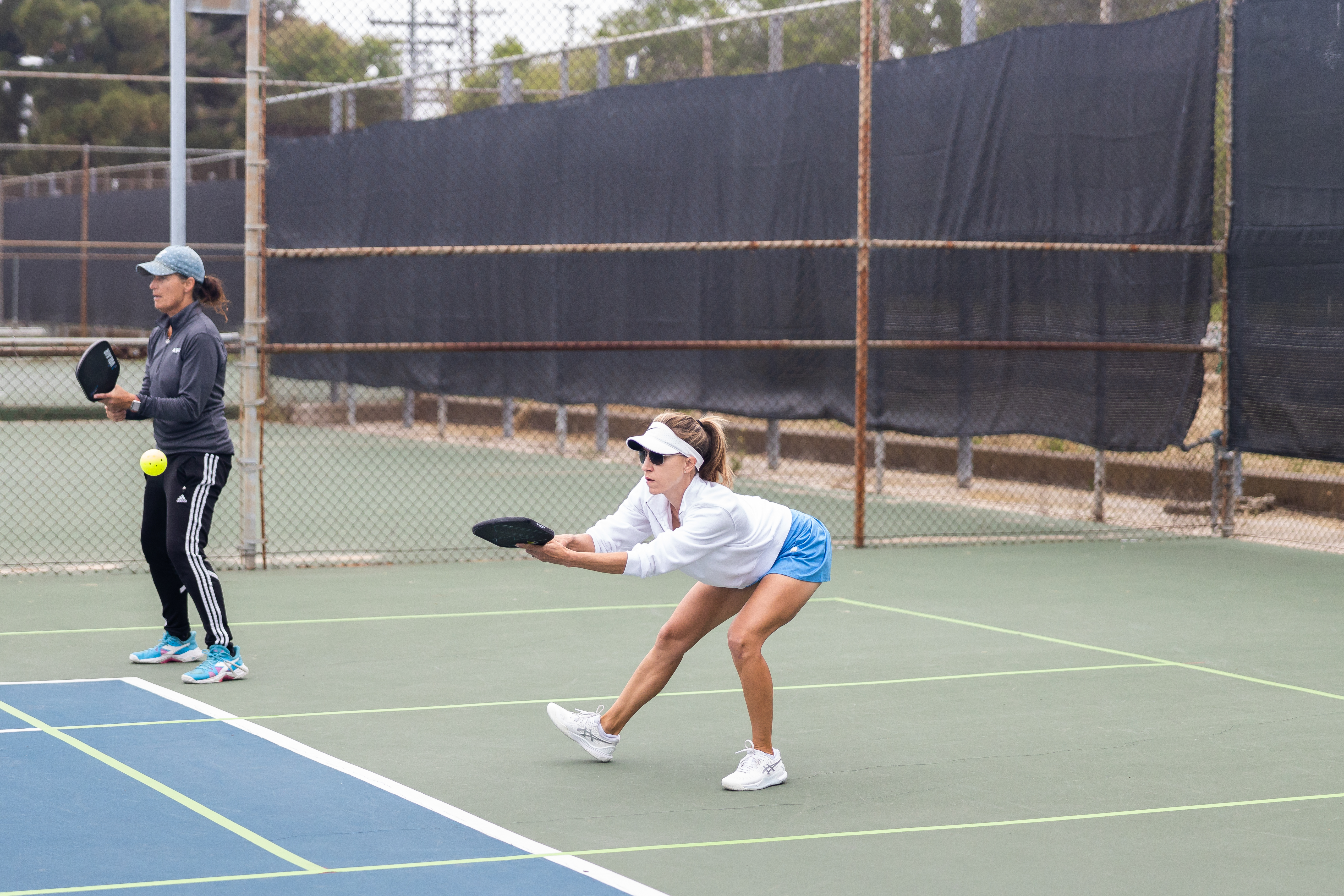




You must be logged in to post a comment.